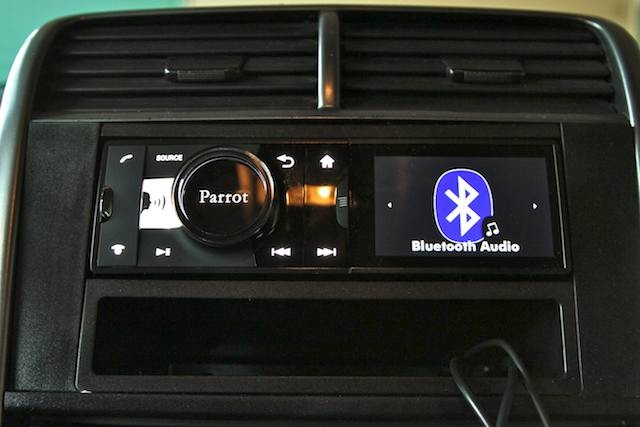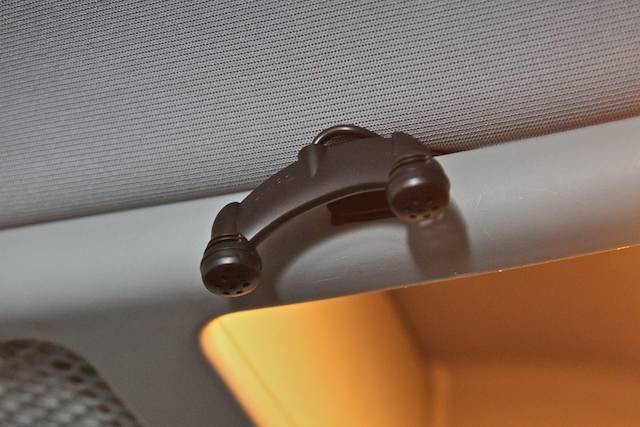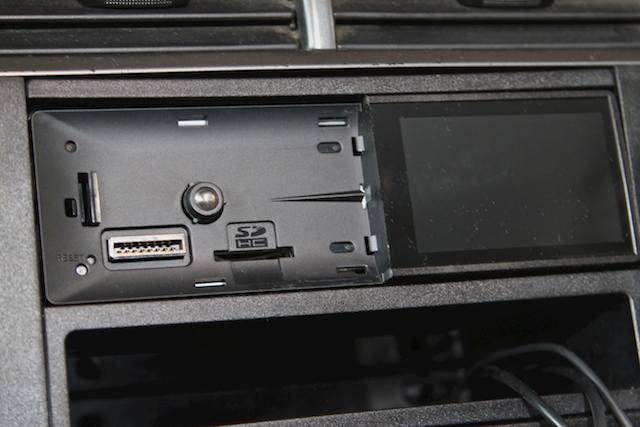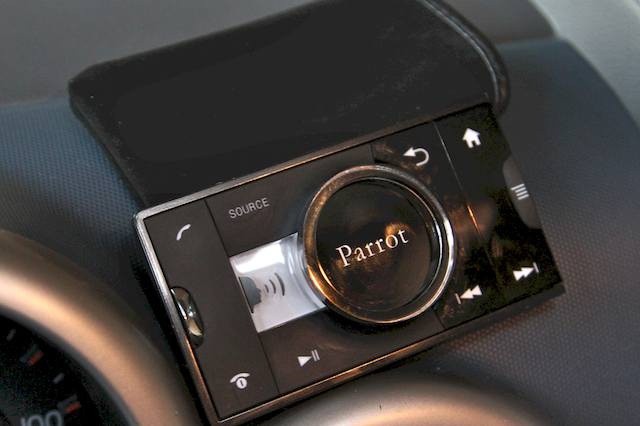Parrot Asteroid Classic Car Sound System: The Deck I Wish I’d Had in High School [Review]
This is the original Parrot Asteroid Classic car stereo head-unit ($349), and it made quite a splash when it launched last year. The single-DIN, 4×55 watt receiver boasts a formidable array of features: Bluetooth connectivity, powerfully accurate voice recognition for both calls and music, a GPS receiver, a bright, 3.2-inch LED screen and a quiver of apps that run off its customized, upgradeable, early-vintage Android 1.5 OS (all of which require a data connection via a dongle).
Though this model was originally called the the Asteroid (no Classic), the Classic nomen was added to lessen confusion as three new models were announced a few months ago. However, the Asteroid Classic still very much in play; in fact, as this review goes live, the Classic is the only member of the Asteroid family currently available, as its new siblings haven’t shipped yet.
With its Android-based OS, you’d be forgiven if you thought the Asteroid Classic was more friendly to Android phones than the iPhone. In fact, the opposite is true, as I’ll explain later. And while it suffers from something that can probably be described as teething trouble, it’s still a lust-worthy system.
The Good:
The two most immediately impressive features are the Asteroid Classic’s beautiful screen, and its superb voice-recognition performance.
First up, the screen: Right off the bat, the most attention-grabbing aspect of the Asteroid Classic was its ability to display, in glorious color, the album cover of whatever track was playing. Almost without fail, the striking feature was the first thing anyone riding in my car noticed. I remember thinking “man, this would have been a huge hit with girls in high school or college.”
For all other audio-related info, the screen was the perfect size, and each page seemed easy to read, with big, crisp, colorful lettering.
While passengers were hypnotized by the screen, I was constantly amazed at how well the Asteroid Classic’s voice-recognition worked.
Once the unit had absorbed all the contact data on my phone, making calls was easily accomplished by simply pressing the call button on the unit, then speaking the name. Answering a similarly required just hitting the accept or reject button after the unit spoke the caller’s name (you can turn this off if you like). Now, this isn’t itself all that impressive; lots of phones can do the same thing, and some portable Bluetooth car speakerphones, like Jabra’s Freeway, even let you answer a call simply by saying “answer” — a truly hands-free experience.
Instead, what impressed me was how flawlessly it worked. The Asteroid Classic’s voice-recognition feature is easily the best-performing I’ve ever tried. Easily. This solid performance was probably helped along by the unit’s twin-headed, directable microphone (when the microphone was first installed, callers on the other end had some trouble hearing me in my noisy Honda Element, due to the fact that the mic was installed near the windshield, which is about a football field’s length away from my face. The problem disappeared once the mic was re-installed closer to me).
Searching for music was even better. I could call up songs by album, artist or playlist (everything but searching for a track directly), and the Asteroid understood pretty much anything I threw at it; even when the unit itself started playing inexplicably random tracks (more on that later), the screen showed it understood what I was saying.
Let’s not forget that the primary function of a head unit is to let the music rip. And this is another area where the Asteroid Classic elicited big grins. Not only did the unit — which comes with four channels of 55 watts each, and a MOSFET amplifier — sound really, really good, but it also let me customize the sound with a dizzying array of options: custom equalizer settings, Virtual Superbass, loudness subwoofer and levels and thresholds, and of course fader and balance.
The unit’s half=length faceplate pops off for security, and there’s an included little bag to house it before it’s slipped into a pocket (and it really is extremely easy to tote around). There’s a billion input options too: Music can be loaded via Bluetooth from a phone, via the semi-hidden SD card slot, into the USB cable via a USB drive, through the 30-pin connector if you have an Apple device or you can simply jack into the 3.5mm aux cable.
The Bad:
The three big areas of disappointment are even more of a let down because the rest of the system is otherwise so impressive, and shows so much promise.
The first is that the magic music-search feature only works with a physically-attached drive: an SD card, a USB drive or a phone that is attached to the 30-pin connector. This is somewhat of a slap in the face for Android users, since Android phones don’t use 30-pin connectors (and now, ironically, neither does the most advanced iPhone), and the only way to connect an Android phone to the system is via Bluetooth. Of course, this isn’t really the Asteroid Classic’s fault — but it’s still a letdown. searching for music manually via the unit’s button-activated menus still works fine though, as do the track and play/pause buttons.
Then there were all the niggly little issues that made the Asteroid Classic seem pretty rough around the edges. These fell into two categories.
There were design elements that didn’t feel quite right, like the fact the screen was sometimes overpowered by the sun during the day, even on the brightest setting; or the unsatisfying feel of the dial, which seemed a little cheap on such an premium unit.
Then there were all the comical (mostly) hiccups. For instance, on one occasion, the unit began blaring the radio at top volume when switched on, and didn’t respond to any input until I removed the faceplate and reset it. That was fun. A few times the unit froze under various circumstances, and I’d have to remove the faceplate and it back in again; and remember I mentioned that the unit sometimes played a seemingly random track after I’d issued a music voice command, and the screen confirmed that it apparently understood what I’d said?
Finally, there’re the apps. While the idea of having an evolving variety of apps available to install in your car’s stereo is ambitious and attractive, the reality in the Asteroid Classic’s case has been a letdown. The screen isn’t nearly big enough for one thing. And the apps are simply not that useful. The map app, for example, is pretty useless, as it’s simply a map app with your GPS postion, and not a navigation map — and even if it was, the screen is too small. There are other apps, like TuneIn radio and Weather. But none of these proved really very appealing to us eon the road; perhaps if the unit had a — larger — touchscreen.
Verdict:
It’s quirky, and one of its key features —the promise of Internet connectivity — is a letdown. Despite that, the Parrot Asteroid Classic’s excellent features and sound still manage to make it worth serious consideration to anyone looking for a high-end car audio stunner.
[xrr rating=70%]
Note: Parrot paid for installation of the unit, which came to just over $100.
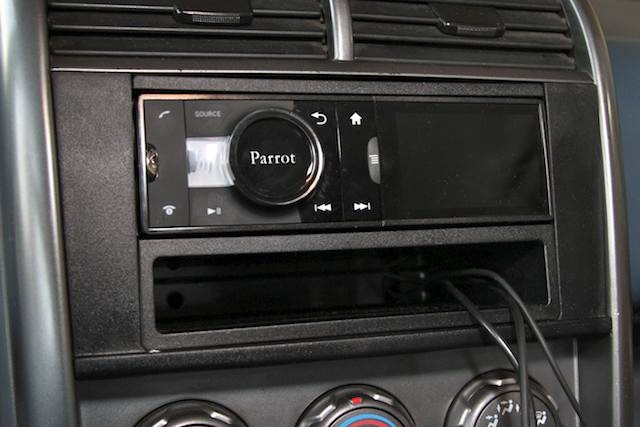
The extra real estate of the double-DIn slot on my Honda Element was filled with a little cubby. The three cables spilling out are for 3.5mm aux input, 30-pin and USB.

